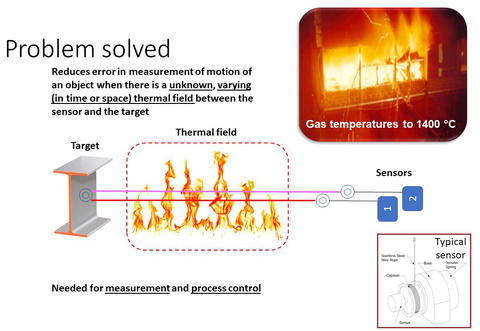Differential compensator to reduce uncertainty in determination of movement of a structural member
Patent Number: 10,247,536
Problem
Patent Description
This invention is a method for estimating thermal expansion in a wire attached to a moving target. In typical tests it is important to measure the motion of a specimen (target) with respect to a fixed reference point, and this is often accomplished by attaching a wire or thread from the target to a sensor in a fixed location. However, in tests with uncertain and elevated temperature profiles, it is not possible to separate the thermal expansion of the measurement wire from the motion of the test specimen.
The new method solves this challenge by adding a second, parallel measurement wire from the target specimen to a second measurement sensor. The second wire has a different coefficient of thermal expansion than the first wire. The difference in the displacement measurements made by the two sensors is not dependent on the motion of the target, but is dependent on the relative thermal expansion coefficients of each wire and on the temperature profile between the sensors and the target. Ifthe thermal expansion of each wire is linear for the range of temperatures that the wires experience, then this 'difference' can be used to calculate the effective thermal profile· and thus the thermal expansion in each wire.
This method is currently being used for measurement of thermal expansion in wires which connect sensors to test specimens in the NIST National Fire Research Lab. The pairing of silicon-carbide and aluminum-oxide fibers has been successful to temperatures in excess of 1000 ° C.

Invention
A new method has been developed for estimating the thermal expansion of a measurement cable (metallic wire or ceramic fiber thread) that is placed in a high temperature environment with an unknown temperature profile and connected to a moving target. This method is to deploy a second measurement cable with a different thermal expansion coefficient in close proximity to the first cable (i.e. through the same thermal environment) and connected to the same target. If the thermal expansion coefficients of the materials are each linear with respect to temperature, then the difference between the measured motion of each wire may be used to compensate for the thermal induced expansion of the wires. This method has provided a significant (>90%) reduction in the uncertainty of measurements made with mechanical sensors (e.g. linear potentiometers) through high temperature environments.
Features
Current practice in the structural fire testing community is to mechanically attach measurement devices which are out of a 'hot zone' to the measurement target which is inside a 'hot zone'. Thermal expansion in the wire or cable used to attach the sensor and target is not considered but can lead to large measurement uncertainty (e.g. 10 mm/m @ 1000 °C). Under similar conditions, application of this method could red uce this uncertainty to less than 1 mm/m at similar temperatures.

